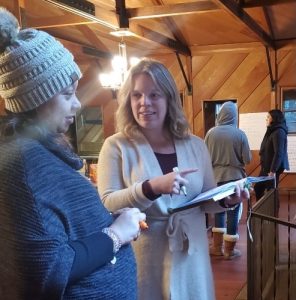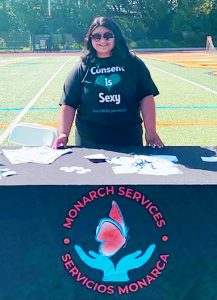by Claudia Boyd-Barrett
Janna Rivas smiled at the three men on the computer screen in front of her.
“So who wants to start us off with their check in today?” she asked cheerfully.
For a few moments, no one spoke. Then a man with long hair raised his hand.
“I am checking in today definitely with joy, grateful to be here again another week,” he said, pausing as if searching for the right words.
“And a little bit of shame at the same time, that I’m having to do this,” he continued. “I just wish I would have learned this approach before it was a necessity.”
It was week four of Positive Solutions, a program of up to a year that aims to help people responsible for domestic violence change their behavior patterns and build healthy relationships. Run by Monarch Services, a domestic violence intervention and prevention agency in Santa Cruz County, the program encourages participants to tune into their emotions, practice nonviolent communication skills and identify negative childhood experiences that may have led them to express emotions in a violent way.
The program reflects a growing movement among anti-violence advocates, domestic violence agencies, and even lawmakers to find effective ways to break the cycle of abuse. They argue that addressing domestic violence solely through the criminal justice system, such as by involving the police or incarcerating people, doesn’t fix the problem or promote healing, and may actually cause additional harm. But more holistic, trauma-informed approaches like Positive Solutions can give people a chance to process the deeper reasons for their behavior and allow them an opportunity to change.
“It just gives you chills,” said Rivas, program manager at Monarch Services. “You’re watching folks process and forgive themselves and each other. These guys are nodding and saying, ‘Yes, that happened to me too. You’re not alone.’”

Since 1994, California has required people convicted of domestic violence and granted probation to attend what’s known as a “batterer intervention program” certified by their county’s probation department. However, violence prevention advocates and researchers have long questioned whether these programs are effective, citing high dropout rates and little evidence that they stop people from reoffending. A 2005 report by the California Attorney General found that dropout rates are as high as 89 percent in some counties.
One criticism of these traditional programs is that they are overseen by the criminal justice system and, as such, tend to take a punitive rather than a healing approach. The style of many programs is authoritative and didactic, critics said, and often reinforces feelings of shame, alienating participants.
“You’re just another person telling them what to do,” said Dalia Ochoa, a facilitator for Positive Solutions who ran “batterer intervention” classes at a probation department before joining Monarch Services.
People of color, who research suggests are overrepresented in court-mandated batterer intervention programs due to societal inequities, also frequently mistrust interventions associated with the criminal justice system due to experiences of police harassment and brutality in their communities, experts said.
California’s state auditor is scheduled to release a new audit later this year on the effectiveness of California’s domestic violence intervention programs.
The audit was done at the prompting of Assemblymember Timothy Grayson (D-Concord).
Now six counties (Napa, San Luis Obispo, Santa Clara, Santa Cruz, Santa Barbara and Yolo) are piloting alternative programs that experiment with different lengths and types of classes, using funding from AB 372, a bill passed in 2018, which authorizes those specific counties to offer an alternative program for individuals convicted of domestic violence.
The pandemic delayed some of the pilots, and it will take more time to determine the outcome, according to a report by the California State Association of Counties.
In the meantime, a handful of local nonprofits are taking the helm, in order to move forward.
The link between childhood trauma and domestic violence
Working with those responsible for domestic violence is new for Monarch Services. Since its founding in 1977 the agency has focused on serving survivors of intimate partner abuse by providing them with emergency shelter, crisis intervention and legal services.
At first glance, the idea of helping those who have committed violence, whom some traditionally viewed as “bad” people, seemed anathema to the organization’s mission, said Co-Executive Director Kalyne Foster Renda. But three years ago, while consulting with survivors on a new strategic vision for the agency, staff heard the same request repeatedly.
“‘I wish there was a program that could help my partner,’” survivors told Foster Renda. “‘I want to stay with them.’ Or, ‘my kids are going to spend time with my ex-partner and I’m worried about the violence.’
“It kept coming up.”
The Monarch Services team began scouring the state for a program they could implement. Most, like Monarch Services, in prior years had held fast to the belief that they should only help the victims of violence, not the perpetrators.
Then agency staff came across The Center in Placerville, a domestic violence intervention and prevention organization that developed the Positive Solutions program about five years ago, and now works with about 90 men and women on any given week. \
Curious, they went to observe the program in action.
“We were blown away by the personal accountability that folks were showing, the support that was happening within the group — that’s really the key to this program, is folks hold each other accountable,” said Foster Renda.
“They allow for vulnerability, and there’s really this pressure on folks to be honest and own their stuff and be able to communicate effectively, in a non-harming way.
“We thought, ‘OK, this looks amazing.’”
Executive Director Matt Huckabay at The Center said his agency developed Positive Solutions after surveying hundreds of people who had been in a relationship where there was domestic violence, and noticing that almost all of those they surveyed had experienced high levels of abuse or neglect as children.
By uncovering this trauma during the program’s weekly sessions, people start to better understand its impact on their behavior as adults, opening the door to healing and change, Huckabay said.
The program also teaches participants to tap into their full range of emotions and learn how to express them. Men especially have often learned as children to repress any emotion other than anger, Huckabay said. If they grew up in abusive households, its common for them to have faced physical violence or loss of affection from a caregiver if they showed emotions such as grief or hurt.
“They learned very early on to connect vulnerability [and] expressions of emotions to physical pain [and] absence of love,” he said.
“Part of the success of the program is really creating a space for men to become very, very vulnerable. To express their feelings of hurt, of shame, their sadness, their grief, and to allow the processing of those emotions where it is viewed as being a strength, not a weakness.”
Identifying suppressed emotions and experiences
Originally designed as an in-person program, Monarch Services is currently holding meetings on Zoom due to the pandemic. Each Positive Solutions session is two hours long, with two trained facilitators. It begins with a check-in, where attendees choose from one of five “core” emotions to express how they’re feeling — joy/happiness, shame, guilt, anger or sadness — and explain why they believed they’re having those feelings.
They’re also asked to note something they’re grateful for.
After talking through any issues that come up, the facilitators introduce a topic for discussion, such as power and control in an abusive relationship, cultural norms around masculinity, or the intergenerational cycle of violence.
In the most recent session, the topic was “Always do your best,” one of “The Four Agreements” from the famous book of that name by Don Miguel Ruiz.
Participants are encouraged to identify how these issues have surfaced in their own lives. The facilitators’ role is to help guide the conversation, ask questions in order to dig deeper, and propose new ways to address or reframe situations involving conflict. However, they try not to dominate the conversation, or act as teachers or experts. Rather, participants are encouraged to support and guide each other.
“All of us are on a healing journey, all of us have trauma, all of us have things to learn and grow from,” Rivas said. “That’s why we are ‘cofacilitators.’ … We have resources to share, we have the training to identify where to go a little deeper, but the group will have a topic and it will flow based on what comes up.”
Ochoa recounted how one man revealed that both his mom and a stepdad beat him as a child, and how he’d also regularly watched his stepdad hit his mom.

Another participant began the program saying his childhood was fine, but a few weeks into the class shared experiences of sexual abuse.
At the end of each class, participants are asked to choose a “stretch” — something practical they will do in the week ahead to implement the skills they’ve been learning. The following week, they report back to the group, describing how the new stretch went.
During the recent Positive Solutions session, one man shared the results of his most recent stretch — starting a conversation with his wife about the possibility of moving back in together. He didn’t get the answer he wanted, he said, but recognized the point at which their dialogue was in danger of escalating into a fight and was able to instead walk away from the situation.
Another participant talked about how, for his stretch, he had been trying to come up with steps he could take to avoid saying something hurtful when he got angry. Rivas advised him to start by taking a deep breath and connecting to how his body feels to try to identify the real reason he is upset before he speaks. “Is it sadness, hurt, shame?” she asked.
“I bet if you said the real thing you were feeling or thinking, without judgement or defense or trying to be right, it would probably be a lot closer to a heart-centered response,” she told him.
So far Monarch Services has worked with 10 men, including the current cohort, in Positive Solutions. It began with two 16-week pilot programs before launching the full program in March. Rivas and Ochoa said they hope to grow participation in the coming year. Feedback from participants has been very positive. Some have regained custody of their children or gained employment. From looking at calls for help to the agency and arrest records, it appears none have gone on to reoffend, they said.
The Center in Placerville, meanwhile, has more in the way of concrete evidence that the program works.
In El Dorado County, out of 75 people who completed the course over the past two years, only one was rearrested for domestic violence within a year of completing the program, Huckabay said.
Studies of other domestic violence intervention programs generally show much lower success rates, with anywhere between 14 percent and 62 percent of men reoffending after completing a program, according to a report reviewing multiple studies of batterer intervention programs.
Jesse James Jarvie, 31, of Santa Cruz is currently in the program at Monarch Services. Jarvie separated from his wife last year and was required to take a course on domestic violence as part of a restraining order against him. He chose Positive Solutions on the recommendation of an attorney, and also because he felt drawn to the class’s focus on finding the root of the problem.
Jarvie said he grew up in a verbally abusive household, but didn’t realize until he did the class that verbal abuse — not just physical abuse — also counts as domestic violence.
“For me it was like, ‘Oh, that’s normal to get in an argument and say things you don’t mean, and then apologize,’” he said.
“I literally thought arguing and fighting and saying mean things was just part of marriage in general. But it’s not OK … I’m aware of that now.”
Held ‘accountable to showing up in new ways’
Positive Solutions does accept referrals from probation departments, courts, and children and family services agencies. But the approach is different, because it’s focused on healing and the practical application of learning. The program emphasizes holding participants “accountable to showing up in new ways,” Huckabay said.
“Behavior change requires more than just education,” Huckabay added. “Education is a piece of it, but then there has to be a whole component of: ‘What do I do next? What new tools do I get? Where are the new tools? How do I use them?’”
Monarch Services is also seeking to address other criticisms of traditional intervention programs.
For one thing, they’re not easily accessible to people looking for help in controlling damaging behavior before it escalates to the point of arrest. They programs also cost on average $25 each week for a year — which can create a financial hardship for participants, many of whom have limited incomes.
Both Monarch Services and The Center welcome participants who want to attend on a voluntary basis, not because they’ve been mandated to by the court. At Monarch Services, the program is free. The Center charges based on a sliding scale but doesn’t turn anyone away. Both organizations rely on outside donations to fund the programs.
Identifying best practicesAdvocates and lawmakers are still trying to figure out exactly how to make intervention programs for domestic violence offenders more effective. An overview of the research on “batterer’s intervention” programs by UC Berkeley found that overall they “have not proven to be particularly effective, nor do they encourage individuals to seek intervention prior to arrest.”
Programs that are “trauma-informed, whole person interventions” could be more successful, the researchers wrote. Other criticisms of traditional domestic violence intervention programs include that they are often unavailable or unwelcoming to non-English speakers, LGBTQ people or those living in rural areas.
California’s lack of funding for programs aimed at those responsible for domestic violence is one major barrier to making those programs more accessible, the report found.
The state simply does not provide funding for these programs. Providers are supposed to make their money from the fees they charge participants, but many can’t afford these fees and drop out as a consequence.
The fees also discourage people from participating in the programs voluntarily as a preventative measure, which could be more effective than waiting until someone is mandated to attend because of a run-in with the police or courts, the report said.
The researchers, who studied five states outside of California with innovative approaches to tackling domestic violence, identified best practices, including putting public health departments in charge of overseeing intervention programming for people who cause harm, rather than the criminal justice system. Programs should also be tailored to the cultural and linguistic needs of each community.
“Through this shift, California can uplift healing, strengthen communities, and move the needle towards realizing transformative justice,” the authors wrote.
Michael Cochrane, co-chair of the Association of Batterers Intervention Programs, which represents programs in Los Angeles, said one problem is that standards vary from county to county and program to program. He said there are competing philosophies among providers as to which approach is best.
Cochrane estimated that about half favor of the providers the traditional approach, which he likened to school. Others, including himself, prefer a “trauma-based” approach, which can include delving into childhood trauma. He hadn’t heard of Positive Solutions, but said the program sounded like the latter.
“All domestic violence is generational,” he said. “I’ve seen more success when you can break down how they got to where they are.”
The Alliance for Boys and Men of Color, a San Francisco-based network of hundreds of community and advocacy organizations, is also calling for the state to move away from responses to domestic violence that are based in the criminal justice system. The organization favors a restorative justice approach, which typically involves collaborating with the person who caused harm, the survivor, family and community members.
More holistic supports for people that have caused harm are also needed, such as job training, substance use treatment and financial assistance, said Eric Morrsion-Smith, the alliance’s executive director.
Other ideas include offering a helpline for people struggling with abusive behavior, which is already available in some countries.
Back at the Positive Solutions session, the participants were wrapping up by expressing how they now felt, and what they were grateful for.
One man said he was ending the session with mixed feelings — both anger and joy. During the session, he had talked about how upset he was that his estranged spouse wouldn’t talk to him. Rivas gently pointed out that he could not force his former partner to do what he wanted, and that perhaps she didn’t talk to him because in the past he had made her feel unsafe. On reflection, the man said he realized he was being unreasonable.
“I’m checking out with some anger toward my inner voice,” he said. “I’m like, ‘Woah. Why do I have this necessity to control her? And why [does]…my inner voice say she needs to forgive me in order for me to be happy?’”
After a pause, the man continued.
“I’m feeling the happiness, the joy, because I do know that I can change that,” he said. “I’m happy that I have this awareness of what I need to work on, and I’m grateful again for this group today, for this really deep stuff.”

Author Claudia Boyd-Barrett is a senior reporter at the California Health Report, a two-time USC Annenberg Center for Health Journalism fellow, and a former Inter American Press Association fellow. Her stories have also appeared in such outlets as the Los Angeles Times, San Francisco Chronicle, and the San Diego Union Tribune.
If you or someone you know is experiencing domestic violence, contact the National Domestic Violence Hotline at 1-800-799-7233 for support and referrals, or text “START” to 88788.
This story was produced in partnership with the California Health Report
Photo at top by fizzles, courtesy of iStock


Sorry but the lasd doesnt care about this